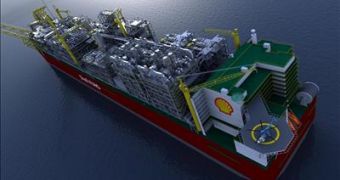Recent news informs us that, in an attempt to freshen up its working agenda, Shell has plans to move its liquefied natural gas (LNG, for short) industry at sea. More precisely, it placed an order that will eventually provide it with the world's first floating LNG plant.
Although the costs for the building of this vessel are expected to amount to a staggering $13 billion / €10 billion, it seems that such an investment is more than overshadowed by the money needed to erect such a facility on land (i.e. about $20 billion / €15.4 billion).
As Shell's FLNG general manager explains, this is because, “We remove the need for pipeline and use about 50% of the raw materials for an equivalent onshore plant.”
Therefore, one can venture to argue that the main drive behind Shell's taking the decision to build the world's first ever such plant has everything to do with financial incentives.
Oil Price informs us that, once work on this project comes to an end, the general public will become acquainted with a floating facility whose overall weight will shame all vessels built throughout history.
More precisely, the Prelude, as its name will be, is to be six times heavier than the world's largest aircraft carrier, and its length will surpass the height of the Empire State Building.
According to the same source, this floating LNG plant is to be built in Korea and then taken to the north-west coast of Australia, where it will be set to work.
The companies in charge of building it are Korea's Samsung Heavy Industries Co. and Technip SA of France.
Apparently, the Prelude will be able to supply 3.6 million metric tons of LNG and 1.3 million tons of gas condensate on a yearly basis.
Shell states that the building of this floating LNG plant will also boost economy, given the fact that $45 billion / €34.65 billion will be added to it and about 1000 job opportunities will be created.
Rumor has it that the facility will become operational in 2017.

 14 DAY TRIAL //
14 DAY TRIAL //